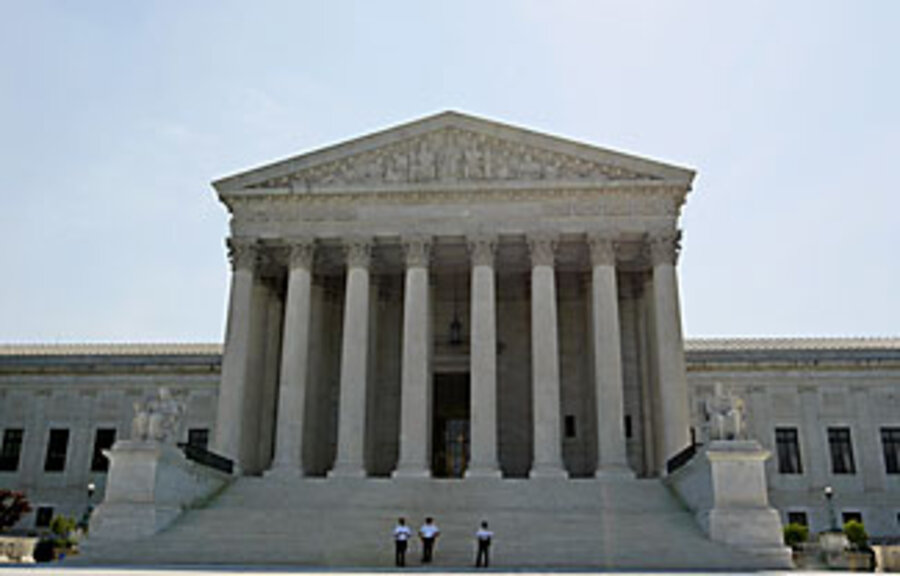US Supreme Court holds to narrow interpretation of the Voting Rights Act
Loading...
The federal Voting Rights Act does not authorize vote dilution lawsuits in voting districts in which a particular racial or ethnic group comprises less than 50 percent of the voting age population.
In a 5 to 4 decision announced on Monday, the US Supreme Court rejected a claim that so-called minority crossover districts qualify for protection under Section 2 of the Voting Rights Act of 1965 (VRA). Instead, the court's conservative wing embraced a narrow view of the law.
Crossover districts are those in which a cohesive minority voting population can elect candidates of its choice by forming a coalition with cross-over votes from whites or other non-minority voters.
The case is important because it establishes ground rules that will apply nationwide during the redrawing of voting districts following the 2010 census. It could result in a reduction of minority districts by encouraging district drafters to pack traditional minority districts with more than 50 percent minority voters, rather than aiming for widespread distribution across several voting districts.
The decision comes in a case challenging the creation of North Carolina's House District 18. State officials tasked with redrawing North Carolina's voting map found themselves caught between two competing laws.
The VRA mandates that new districts may not be drawn in such a way as to dilute the existing political clout of minority voters in minority voting districts. But North Carolina has a law requiring that counties not be split up within voting districts.
State officials discovered that if they adhered to the "whole county provision" of state law, the minority voting age population in District 18 would be reduced from 39 percent to 35 percent.
Concerned that the reduction would amount to illegal minority vote dilution, the officials concluded that they were required to ignore the state's whole county provision to avoid violating the federal voting rights law.
One of the affected counties filed suit, claiming the state law's whole county provision should be upheld. The North Carolina Supreme Court agreed.
In affirming that decision, a plurality of the US Supreme Court ruled that the Voting Rights Act protects the voting clout of minority voters in districts in which minority voters comprise more than 50 percent of the voting age population.
"The rule provides straightforward guidance to courts and to those officials charged with drawing district lines to comply with Section 2 [of the VRA]," wrote Justice Anthony Kennedy in the plurality decision.
"We decline to depart from the uniform interpretation of Section 2 that has guided federal courts and state and local officials for more than 20 years," he said in the opinion.
"Minority groups in crossover districts cannot form a voting majority without crossover voters," Justice Kennedy wrote. "In those districts minority voters have the same opportunity to elect their candidate as any other political group with the same relative voting strength."
Chief Justice John Roberts and Justice Samuel Alito joined Kennedy's decision in full. Justices Clarence Thomas and Antonin Scalia concurred in the judgment, but did not agree with the underlying reasoning.
In a dissent, Justice David Souter said the plurality was being unfaithful to the intent of the Voting Rights Act.
"Minority voters in districts with minority populations under 50 percent routinely elect representatives of their choice," he said. "The effects of the plurality's unwillingness to face this fact are disturbing by any measure and flatly at odds with the obvious purpose of the act."
Justice Souter added, "States will be required under the plurality's rule to pack black voters into additional majority-minority districts, contracting the number of districts where racial minorities are having success in transcending racial divisions in securing their preferred representation."
Justice Kennedy said that enforcing the VRA to protect minority voting clout in districts where minority voters did not constitute a majority would "grant special protection to a minority group's right to form political coalitions."
He added, "Section 2 does not impose on those who draw election districts a duty to give minority voters the most potential, or the best potential, to elect a candidate by attracting crossover voters." The law safeguards those who already possess the "potential to elect" favored representatives from losing that potential through vote dilution, he wrote.
In a dissent, Justice Ruth Bader Ginsburg said the high court's decision "severely undermines" the aim of the act. "Today's decision returns the ball to Congress' court," she wrote. "The legislature has just cause to clarify beyond debate the appropriate reading of Section 2."
The case is Bartlett v. Strickland (07-689).






